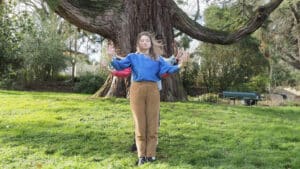Soms begint een festival pas echt nadat de zalen leeggestroomd zijn. Rode draden worden zichtbaar, thema’s zoemen na, onderzoek gaat voort, archieven worden ontsloten. Wat mij opviel bij de negentiende, wat kleinere editie van Cinedans, is dat er veel werk was over de kwetsbaarheid van het lichaam. Niet gek na een pandemie, tijdens een oorlog en met een nog veel grotere mondiale crisis voor de deur. We moeten ons op een andere manier tot ons kwetsbare lichaam verhouden, en kunstenaars lopen daarbij op ons vooruit.
Het kwetsbare lichaam
Neem Shells, de korte film van Regisseur Marie-Magdalena Kochová en choreograaf Jarek Lambor
die de Student Award heeft gewonnen. In de hoofdrol danst de inmiddels overleden Jan Minarík, uit het gezelschap van Pina Bausch. De fysiek kleine ruimte van de lift en zijn eigen, door ziekte en ouderdom beperkte lichaam gaan een ontroerend duet aan, dat de kijker zeker nog een tijd bijblijft. Door het leeftijdsverschil pakken studentenfilms over ouderen niet altijd even geloofwaardig uit, maar deze film boeit van begin tot eind. Veel daarvan komt ook op conto van Minarík
Op een andere manier kwetsbaar is het lichaam in de kortfilm Songs from the Compost: Mutating Bodies, Imploding Stars van Egle Budvytyte, waarin dansers de lichamelijke autonomie opgegeven lijken te hebben, en in symbiose met compost, paddenstoelen en andere ondergrondse krachten lijken voort te bestaan. Hypnotiserende muziek en ijle zang beschrijven de dansers als non-binaire cyborgs die langzaam steen worden. Als dat de toekomst is, dan ziet het er niet rooskleurig uit.
Wezenloos maar vastberaden bewegen ze zich voort als krabbetjes, op handen en voeten, maar met de buik naar boven. Een vormeloos embryo ligt tussen de benen van een danser, navelstreng nog intact. Het kleurenpalet is al even uitgebleekt als het emotionele materiaal. De aanvankelijke ergernis (heeft er nou alweer iemand Donna Haraway gelezen?) sloeg bij mij snel om in nieuwsgierigheid. Is dit zoals een nieuwe generatie makers onze toekomst ziet, zijn dit de angsten, de verwachtingen?
Dansen met een dagboek
Lichamelijkheid speelt op een andere manier de hoofdrol in twee VR-projecten van het festival. Dear Diary van choreografe Margherita Bergamo Meneghini is haar PhD onderzoeksproject waarin Cinedansbezoekers konden participeren. In een korte 360-gradenfilm zien we tieners in hun vrije tijd, waarbij het geheim dagboek van een van hen is gevonden. We duiken in het lichaam van Eve, een van de tieners. Ze kijken ons aan, dagen ons uit en vragen ons om mee te dansen met de andere tieners, we krijgen het dagboek in handen gedrukt, maar het wordt er meedogenloos weer uit losgetrokken.
Met het werk onderzoekt Margherita Bergamo Meneghini hoe onze lichamelijke ervaring voelt in VR: voelen we ons meer of minder betrokken, ervaren we het lichaam van Eve als ons eigen lichaam? Interessante vragen, waar ik de komende tijd meer over wil weten. Kunnen we de grens tussen eigen en ander lichaam overstijgen? En wat voor consequenties heeft dat, zowel in narratieve als filosofische zin?
In dit werk was de indringende blik van de andere tieners bepalender dan mijn dansende lichaam. Ik moest, of liever: kon, de dansende armen volgen, maar omdat je steeds een fractie van een seconde later bent dat je geprojecteerde armen, voelde die niet “echt” als mijn armen, of bewegingen die ik initieerde.

Neurowetenschappers en dans: een mooi onderzoek
Een ander onderzoeksproject is dat van neurowetenschappers Ineke van der Ham (Universiteit Leiden) en Anouk Keizer (Universiteit Utrecht). Zij onderzoeken de manieren waarop VR door uiteenlopende mensen beleefd wordt. In welke mate beïnvloedt je achtergrond en je eigen fysieke bewustzijn je ervaring in VR of, concreter: gaan dansers anders met de virtuele ruimte om dan niet-dansers? Cinedans nodigde Ineke en Anouk vorig jaar uit om tijdens Cinedans FEST een onderzoek te starten naar ‘embodiment’ en ‘sense of presence’ in de virtuele ruimte. Door middel van VR wordt gekeken of je eigen lichaamsbewustzijn je gevoel voor ruimte en plaats de VR beïnvloedt.
De onderzoeksresultaten zijn nog niet gepubliceerd. Daar gaat uiteraard wat tijd overheen. Wel was het interessant om te zien hoe het onderzoek uitgevoerd werd. Ik kon met mijn avatar ronddwalen in een kamer en kijken wat ik wel en niet kon beïnvloeden (waarom gaat deze la nou niet open?). Daarna kreeg ik een vragenlijst, met vragen over hoe ik de ruimte heb ervaren, maar ook over mijn ruimtelijk inzicht. Ik moest 3D objecten die van verschillende posities te zien waren matchen, en mijn strategie toelichten: draaide ik in mijn hoofd de objecten, of draaide ik mijzelf rond de objecten?
Eindelijk! Een dansfilmarchief!
Niet allen het onderzoek gaat verder, ook is er een nieuw initiatief dat zeer veelbelovend is: een dansfilmarchief!
In samenwerking met Podiumkunsten.nl en op initiatief van regisseur Jellie Dekker en Cinedans, zijn de eerste stappen gezet voor een nationaal archief voor dansfilm. Het is de bedoeling dat een ruime eeuw aan dansfilms te ontsluiten en vindbaar te maken voor publiek, programmamakers en onderzoekers. Er is een schat aan materiaal toegankelijk, maar helaas zijn er ook ontzettend veel banden gewist. Eeuwig zonde.
Neem bijvoorbeeld het dansprogramma dat Hans van Manen ooit had op de Nederlandse tv, kostelijk om te zien, met een pas de deux van een piepjonge Alexandra radius en Jaap Vlier op de trappen van het Stedelijk. Tegelijk stemt het treurig dat er nu alleen op een ver weggestopt kanaal serieuze belangstelling is voor dans. Er zijn zulke mooie films gemaakt in het Point Taken programma bijvoorbeeld. Het is voor de podiumkunsten en de film dus een waardevol project om de dansfilm te ontsluiten. Ik verheug me op nieuwe kennismakingen met archief materiaal en het herzien van geliefde films.
